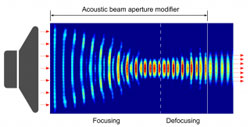New Metamaterials Device Focuses Sound Waves Like a Camera Lens

Sz-Chin Steven Lin, Penn State<br> <br>The acoustic beam aperture modifier can effectively shrink or expand the aperture of an acoustic beam with minimum energy loss and waveform distortion. With such an acoustic lens, the need for a series of expensive transducers of different sizes is eliminated.<br>
This invention will benefit almost all current sonic and ultrasonic applications, such as ultrasonic nondestructive evaluations and ultrasonic imaging. The device should also provide more accurate and efficient high-intensity focused ultrasound(HIFU) therapies, a non-invasive heat-based technique targeted at a variety of cancers and neurological disorders.
Optical metamaterials have been widely studied in the past decade for applications such as cloaking and perfect lenses. The basic principles of optical metamaterials apply to acoustic metamaterials. Artificial structures are created in patterns that bend the acoustic wave onto a single point, and then refocus the acoustic wave into a wider or narrower beam, depending on the direction of travel through the proposed acoustic beam aperture modifier. The acoustic beam aperture modifier is built upon gradient-index phononic crystals, in this case an array of steel pins embedded in epoxy in a particular pattern. The obstacles (steel pins) slow down the acoustic wave speed in order to bend the acoustic waves into curved rays.
According to post-doctoral scholar and the paper’s lead author, Sz-Chin Steven Lin, while other types of acoustic metamaterials also could focus and defocus an acoustic beam to achieve beam aperture modification (although prior to this work no such beam modifier has been proposed), their device possesses the advantage of small size and high energy conservation. Currently, researchers and surgeons need to have many transducers of different sizes to produce acoustic waves with different apertures. This is analogous to having to swap out lenses on a camera to change the lens’s aperture. With this invention, by changing the modifier attached to the transducer the desired aperture can be easily attained.
“Design of acoustic beam aperture modifier using gradient-index phononic crystals,” by Lin, Bernhard Tittmann, and Tony Jun Huang, is the first design concept for an acoustic beam aperture modifier to appear in the scientific literature, and no acoustic beam modifier device is available in the market. As a result, the authors expect their device could have wide applications across several important acoustic fields, from medical ultrasound to higher sensitivity surface acoustic wave sensors to higher Q factor resonators. The team is currently making a prototype based on this design.
Support for their research came from the National Science Foundation, the National Institutes of Health (NIH) Director’s New Innovator Award, and the Penn State Center for Nanoscale Science (MRSEC). Sz-Chin Steven Lin is a post-doctoral scholar in the Penn State Department of Engineering Science and Mechanics: ssl130@psu.edu. Bernhard Tittmann is Schell professor and professor of engineering science and mechanics: brt4@psu.edu. Tony Jun Huang is associate professor of engineering science and mechanics: juh17@psu.edu.
The Materials Research Institute is Penn State’s home for interdisciplinary materials research, supporting over 220 engineers and scientists and 800-plus graduate students, post-docs and visiting scientists. Visit MRI at www.mri.psu.edu for other recent materials discoveries at Penn State.
Media Contact
All latest news from the category: Materials Sciences
Materials management deals with the research, development, manufacturing and processing of raw and industrial materials. Key aspects here are biological and medical issues, which play an increasingly important role in this field.
innovations-report offers in-depth articles related to the development and application of materials and the structure and properties of new materials.
Newest articles

Silicon Carbide Innovation Alliance to drive industrial-scale semiconductor work
Known for its ability to withstand extreme environments and high voltages, silicon carbide (SiC) is a semiconducting material made up of silicon and carbon atoms arranged into crystals that is…

New SPECT/CT technique shows impressive biomarker identification
…offers increased access for prostate cancer patients. A novel SPECT/CT acquisition method can accurately detect radiopharmaceutical biodistribution in a convenient manner for prostate cancer patients, opening the door for more…

How 3D printers can give robots a soft touch
Soft skin coverings and touch sensors have emerged as a promising feature for robots that are both safer and more intuitive for human interaction, but they are expensive and difficult…





















